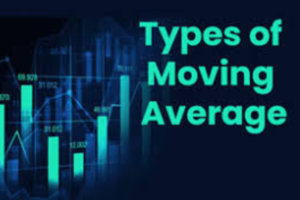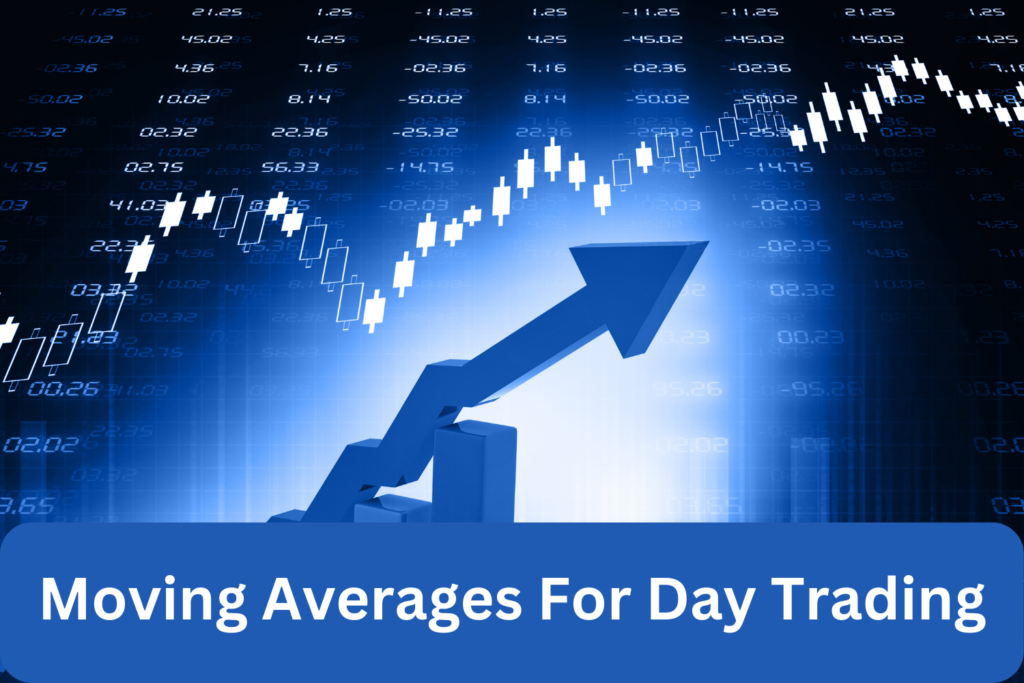Day trading, the fast-paced world of chasing intraday profits, thrives on understanding market movements. While there’s no magic formula, moving averages (MAs) are popular tools to identify trends and potential entry/exit points. But what’s the best moving averages for day trading? Get ready, as we explore the strategies and realities of using MAs for day trading.
What is the best moving average?
Choosing the “best” moving average depends on how a trader likes to do things and what they’re trading. There are two main types: Simple Moving Average (SMA) and Exponential Moving Average (EMA).
Simple Moving Average (SMA):
- It looks at average prices over a set time.
- Good for showing general trends over a longer time.
Exponential Moving Average (EMA):
- Focuses more on recent prices, reacting faster to changes.
- Preferred by short-term traders for quicker responses to what’s happening now.
Here are some popular moving averages for day trading:
- Short-term: 5-period EMA, 10-period SMA
- Mid-term: 20-period EMA, 50-period SMA
- Long-term: 200-period SMA
The decision between SMA and EMA depends on how long someone plans to trade and how much they care about the latest price moves. There’s no one “best” moving average – it changes based on how someone likes to trade and what they’re trying to achieve. Traders often try different types and timeframes to see what fits their style and the specific market they’re working in.
Is there a Perfect Set of Moving Averages for Day Trading?
The answer to this question is a resounding no. There is no single “perfect” set of moving averages (MAs) for day trading or any other trading style for that matter. Here’s why:
Market dynamics are complex and ever-changing. What works in a trending market might not work in a volatile one, and what works for one trader might not work for another due to individual risk tolerance and trading style.
Moving averages are lagging indicators. They react to past price movements, not predicting future ones. This means they can help identify trends and potential support/resistance levels, but they can also generate misleading signals, especially in choppy markets.
Different types of MAs serve different purposes. Short-term MAs like the 5-period EMA react quickly to price changes, while longer ones like the 200-period SMA smooth out fluctuations and identify long-term trends. Each has its advantages and disadvantages, and the “best” choice depends on your specific needs.
Instead Of Searching For A Perfect Set, Focus On:
- Understanding the different types of MAs and their strengths/weaknesses.
- Backtesting different combinations of MAs with historical data to see what works best for you and your trading style.
- Combining MAs with other technical indicators and fundamental analysis for a more comprehensive understanding of the market.
- Adapting your approach based on market conditions.
Trading involves inherent risks, and MAs are just one tool in your toolbox. Don’t rely solely on them and always prioritize proper risk management and a sound trading plan.
Types Of Moving Averages – Trading Strategies

Moving averages are a popular technical analysis tool used by traders to identify trends and potential entry and exit points for trades. There are several types of moving averages that traders can use in their trading strategies. The two most common types are the simple moving average (SMA) and the exponential moving average (EMA).
The simple moving average is calculated by taking the average closing price of a security over a set period, such as 10 days, and plotting it on a chart. The EMA, on the other hand, gives more weight to the most recent prices, making it more responsive to changes in the security price.
Moving Average Is Classified Into Nine Types
- Simple moving average (SMA)
- Exponential moving average (EMA)
- Double Exponential Moving Average (DEMA)
- The Triple Exponential Moving Average (TEMA)
- Linear Regression
- Displacing the moving average
- The Time Series Forecast (TSF)
- Wilder moving average
- Weighted moving average
Traders can use moving averages in a variety of trading strategies.
- One common strategy is the crossover strategy, which involves using two moving averages, such as a short-term and a long-term moving average, and looking for the crossover of these two lines as a potential signal for a trend reversal.
For example, if the short-term moving average crosses above the long-term moving average, it may signal a bullish trend, while a crossover in the opposite direction may signal a bearish trend.
- The other popular strategy is the moving average ribbon, which involves plotting multiple moving averages on a chart to identify support and resistance levels and potential trend changes. Traders can also use moving averages to determine trend direction and strength, as well as to validate signals from other technical indicators.
Moving averages can also be used as dynamic support and resistance levels in trading strategies. For example, when a security’s price is above its moving average, the moving average can act as a support level, while the moving average can act as a resistance level when the price is below it. Traders can use these levels to determine potential entry and exit points for trades.
To sum up, moving averages are a versatile tool that can be used in a variety of trading strategies. Whether it’s identifying trend direction and strength, using crossovers to signal potential trend reversals, or using moving averages as dynamic support and resistance levels, traders have several options for incorporating moving averages into their trading strategies.
As with any technical analysis tool, traders need to test different moving average settings and strategies to find what works best for their trading style and goals.
What Are The Benefits Of Using Moving Averages For Day Trading?

Moving averages (MAs) are like handy assistants for day traders, helping them navigate the quick ups and downs of the market. Here’s how they benefit you:
Spotting the Trend: Imagine a moving line on your chart, showing the average price over a set period. This line helps you see if the price is generally going up (uptrend), down (downtrend), or sideways (range-bound). This helps you decide when to buy (uptrend) or sell (downtrend).
Support & Resistance Levels: Think of support as a hidden floor and resistance as a ceiling for the price. MAs can act like these levels, where the price often bounces off before going up/down again. This helps you predict possible buying/selling opportunities.
Confirmation Signals: MAs don’t predict the future, but they can confirm other trading signals you might use. Imagine another indicator suggesting a buy, but you’re unsure. If the price also crosses above a key MA, it adds confidence to your decision.
Use MAs wisely, and they can be your valuable allies in the fast-paced world of day trading!
What Are The Risks And Limitations To Moving Averages In Day Trading?

While moving averages (MAs) can be helpful guides in day trading, they’re not without their downsides. Here’s the lowdown on their risks and limitations:
Lagging: Imagine you’re driving and watching the rearview mirror. MAs work similarly, showing past price movements, not predicting future ones. This can be tricky in fast-moving markets where prices change quickly.
False Signals: Just like a foggy mirror might blur your vision, MAs can sometimes mislead you. They might suggest a trend change when it’s just a temporary blip, leading to bad trades.
Over-Reliance: Don’t get too attached to your MA friends! Relying solely on them can be risky. They should be one tool in your toolbox, combined with other indicators and analysis for a more informed picture.
Market Dependence: What works in a calm market might not translate to a stormy one. Different market conditions require different approaches, and MAs might need adjustments accordingly.
Always keep in mind:
- MAs are tools, not guarantees. Use them with caution and always manage your risk.
- Don’t blindly follow every signal. Think critically and combine MAs with other strategies.
- Adapt your approach to the market. What works today might not work tomorrow.
By understanding these limitations, you can use MAs effectively while avoiding their pitfalls. Happy (and informed) trading!
To sum up
Forget about finding the perfect moving average for day trading—it doesn’t exist! Different markets and trading styles need different approaches. Instead, think of moving averages (MAs) as helpful tools, each with its strengths and weaknesses.
Short-term MAs, like the 5-period (EMA), react quickly to changes, which is good for catching early trends but can give false signals in choppy markets.
Mid-term MAs, such as the 20-period EMA, smooth out some of the noise, helping you see bigger trends and possible support/resistance levels.
Long-term MAs, like the 200-period Simple Moving Average (SMA), show the big picture, helping you understand the overall market direction but might miss quicker opportunities.
Remember, there’s no one “best” MA. It depends on how you like to trade, your risk tolerance, and what the market is doing. Don’t rely only on MAs—use them with other tools, test different strategies, and be ready to change your approach as needed. Good luck navigating the market with your trusty MAs!
FAQs
Which moving average is the most accurate?
The accuracy of a moving average depends on the market conditions and trading strategy. There isn’t a one-size-fits-all answer; traders may use Exponential Moving Averages (EMA) for responsiveness or Simple Moving Averages (SMA) for smoother trends.
Do day traders use EMA or SMA?
Day traders often use Exponential Moving Averages (EMA) due to their responsiveness to recent price changes. EMAs give more weight to recent data, making them popular for short-term trading.
How to use 5 8 13 EMA?
Traders use the 5, 8, and 13 EMA combinations for trend analysis. A crossover of the shorter EMAs above the longer ones can signal an upward trend, while a crossover below may indicate a downward trend.
What is the 5 10 20 EMA strategy?
The 5, 10, and 20 EMA strategy involves using three exponential moving averages. A bullish crossover of the 5 EMA above the 10 and 20 EMAs can be a buy signal, while a bearish crossover may signal a sell.
What is the 8 21 EMA strategy?
The 8 and 21 EMA strategy focuses on the Exponential Moving Averages of 8 and 21 periods. Traders look for crossovers: a bullish crossover (8 EMA crossing above 21 EMA) can indicate a buy, while a bearish crossover may signal a sell.
What is the 9 and 30 EMA trading strategy?
The 9 and 30 EMA trading strategy involves the Exponential Moving Averages of 9 and 30 periods. Traders observe crossovers for potential buy or sell signals, where the 9 EMA crossing above the 30 EMA can be a bullish signal, and the opposite may be bearish.


